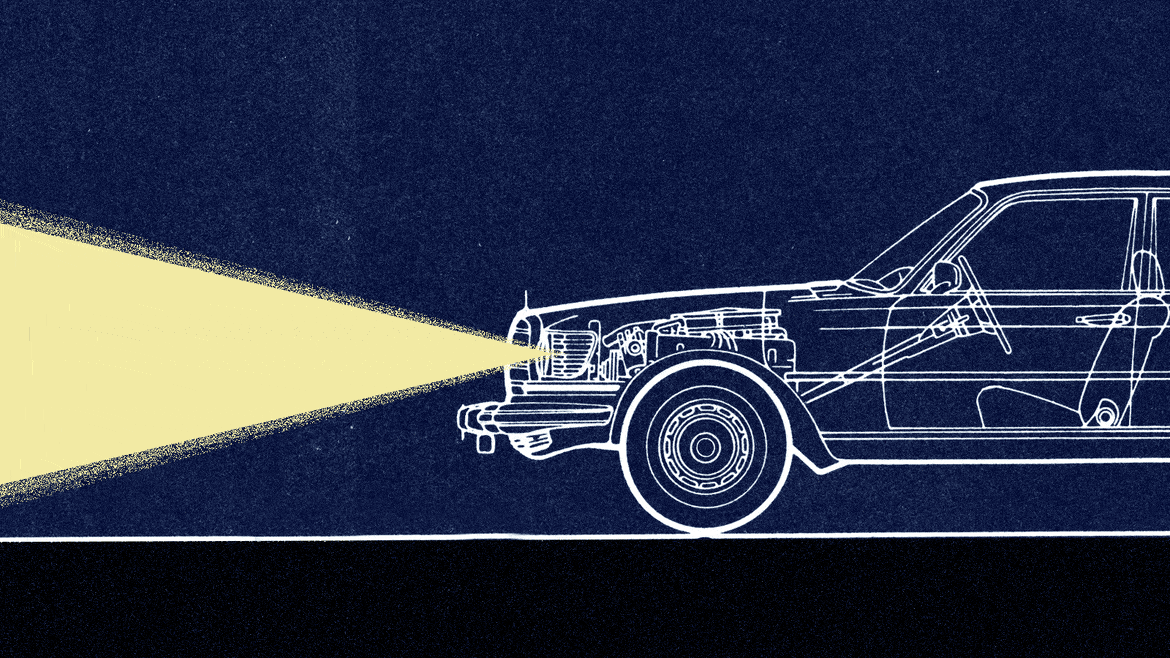This Tech May Stop High Beams From Blinding You at Night

A disproportionate amount of driver and pedestrian deaths occur at night, partially due to low visibility, according to AAA. While only a quarter of all driving in the U.S. takes place at night, that’s when 77 percent of all pedestrian deaths and 50 percent of all driver deaths occur.
However, 64 percent of drivers in the U.S. “do not regularly use their high beams,” according to AAA. Drivers are choosing the risks of darkness over the risks of glare.
“We’ve all been there: You’re driving at night, squinting ahead, wishing you had more light to see the road, but you don’t switch on your high beams because you don’t want to blind oncoming drivers,” AAA wrote in a press release.
The press release was an endorsement of adaptive driving beams (ADB), a headlight technology that has been available in Europe and Canada for years but which was just legalized for installation in the U.S. in 2022. ADB headlights “alter the beam pattern to reduce glare for oncoming drivers without losing any forward lighting,” according to AAA. This means that drivers can keep their high beams on without worrying they will cause glare for drivers coming the other way.
Can Rivian’s Cheaper Electric SUVs Help Stave Off Ruin?
ADB headlights “use automatic headlight beam switching technology to shine less light on occupied areas of the road and more light on unoccupied areas,” according to the National Highway Traffic Safety Administration (NHTSA).
ADB headlights link the headlights to a camera system which detects other road users and then is able to “dim out the specific part of the headlamp beam pattern that’s pointed at those other road users while maintaining essentially a high beam everywhere else,” Mathew Brumbelow, a senior research engineer at the vehicle research center at the Insurance Institute for Highway Safety (IIHS), told The Daily Beast.
A spokesperson for the auto lobbying group the Alliance for Automotive Innovation (AAI) said headlight technology can “save lives and avoid collisions” and that ADB headlights were developed by automakers to “advance driving safety without interfering with the visibility of other drivers.”
Brumbelow has conducted studies to track whether oncoming drivers could detect glare from oncoming drivers that were using ADB lights. According to him, “they weren’t.”
“They basically rated them the same level as a low beam,” Brumbelow said.
Tests for Flying Car Underway, Promising Jetsons-Style Future
ADB lights result in “an increase in roadway illumination of up to 86 percent compared to standard lights,” according to AAA. In fact, the technology is “one of many important safety features you should look for when shopping for a new car,” AAA says.
But NBC News reported that there are no vehicles with ADB headlights available for sale in the U.S. Brumbelow said that it’s still “a few years away” before ADB headlights will be available to U.S. consumers. The reason that consumers can’t buy cars with ADB lights, despite the law enabling them to since 2022, is due to NHTSA regulations that came along with their legalization of the technology, according to Brumbelow.
The NHTSA rule on ADB technology aimed “to strike a balance between improving seeing distance and limiting glare to other road users,” according to the NHTSA.
But Brumbelow said automakers find the regulations in the NHTSA rule to be too strict and, in one case, “impractical.” In a 2022 petition to the NHTSA, AAI wrote that the NHTSA rule “contains several requirements that are either not practicable or not reasonable.”
“We’ve urged NHTSA to strike a balance that permits wider and faster adoption of ADBs and advanced safety headlight systems on America’s roads,” an AAI spokesperson said in an emailed statement to The Daily Beast.
Forget Tesla and Electric Cars. E-Bikes Are the Future of Transportation.
The petition points out two specific issues they have with the NHTSA’s rule: what they say is a conflict between two different regulatory requirements as well as a requirement they say is too strict and expensive, which they say discourages widespread manufacturing.
First, the AAI states that the NHTSA regulations for ADB mandate two conflicting parameters for “how much light may be allowed above the horizontal,” which they say makes it “practically impossible” to develop a compliant ADB system. “Conflicting regulatory requirements” need to be resolved before manufacturers can self-certify their vehicles for the U.S. market, according to AAI.
Second, the AAI points out a regulation which they think is too strict by prohibiting “lower cost” ADB systems from the market. “Lower resolution” ADB systems, which do not comply with the NHTSA regulations, are prohibited. But these “lower resolution” systems “still provide a significant safety belt,” according to AAI. Easing the regulations to allow these “lower resolution” systems to comply would “facilitate more rapid deployment of a number of more affordable ADB systems,” according to AAI.
“I think if the regulation is not adjusted it is really going to restrict the number of vehicles where it’s available because the technology that’s required to meet it would be more expensive and that will limit the ability for automakers to offer that on a wider range of vehicles,” Brumbelow said.
“If not adjusted, parts of this rule stand as an obstacle to the deployment of this important safety technology in the U.S. market,” the AAI petition read. “Limiting deployment runs counter to the public’s best interest—particularly with respect to affordability, equity and ensuring the technology is more widely accessible to consumers.”
Petitions for reconsideration of the NHTSA rule “are currently under review,” a source familiar with the matter told The Daily Beast. Until then, U.S. consumers will have to wait and make do with the headlights they’ve got.
Get the Daily Beast's biggest scoops and scandals delivered right to your inbox. Sign up now.
Stay informed and gain unlimited access to the Daily Beast's unmatched reporting. Subscribe now.

